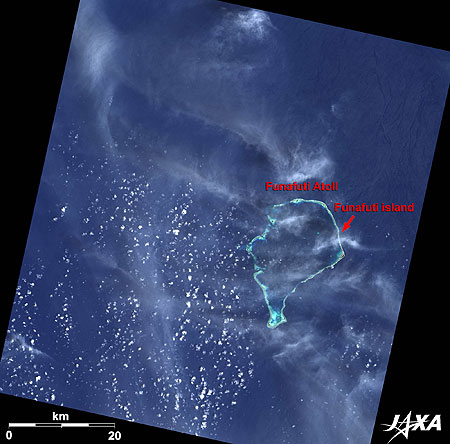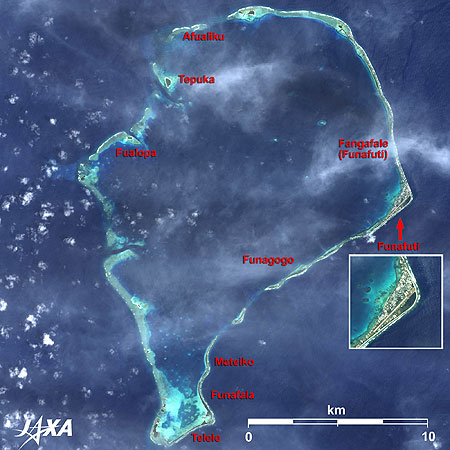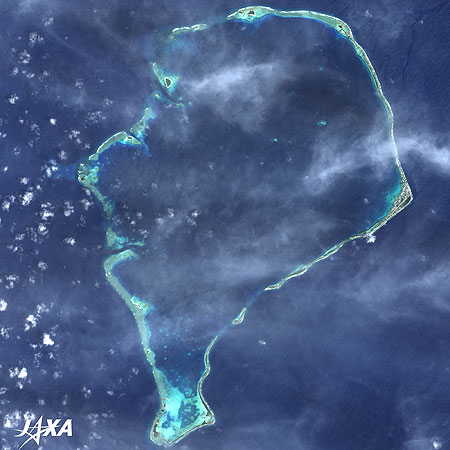

Latest Observation
2010.06.23 Wed
Tuvalu: Islands in Danger of Submerging
Figure 1 depicts the largest Funafuti Atoll in the Tuvalu Islands (formally known as the Ellice Islands), as observed by ALOS (“Daichi”) on January 18, 2009. It is a coral-reef lagoon 25 km north-to-south, 18 km east-to-west, and surrounded by small islets. Funafuti, visible on the rightmost end of the lagoon, is the largest islet and the capital of the island nation of Tuvalu.
Tuvalu comprises four coral reefs and five atolls, located about 1,000 km north of Fiji in the South Pacific. Tuvalu, with an area of 26 square kilometers, is the fourth smallest country in the world, larger only than Vatican City, Monaco, and Nauru in the Pacific Ocean. The Ellice Islands became a British protectorate in 1892 together with the Gilbert Islands (a part of the Republic of Kiribati) to the north-northwest, and became a colony in 1915. The main inhabitants of Tuvalu are Polynesian and those of the Gilbert Islands are Micronesian; therefore, the two islands dissociated in 1975. They achieved independence in 1978 and became members of the Commonwealth of Nations.
caption on
caption off
Fig. 2. Enlarged Image of Funafuti Atoll
Funafuti Atoll (kmz, 3.02 MB, Low Resolution) as seen on Google Earth
Figure 2 is an enlarged image of Funafuti Atoll. The capital, Funafuti, is located at the easternmost bend (right) of the atoll and it possesses the only airport in Tuvalu, the airstrip of which is slightly wider than a road and has no kind of lighting or guidance lights. Air Pacific operates two flights per week between it and Suva, the capital of Fiji. Since this airstrip is the only open space in the atoll, it is also used as a playground and a football field by the people.
The name Tuvalu consists of Tu, meaning “consist of,” and Valu, meaning “eight.” Thus, it means “a country consisting of eight islands” in the Tuvaluan language.
At the beginning of their independence in 1978, Tuvalu was composed of eight inhabited small islands. Later people moved to an uninhabited islet called Niulakita. Therefore, the new design of the national flag now has nine stars reflecting the number of islands. The name of the nation, however, has not been changed.
Economy of Tuvalu
The population of the Tuvalu Islands is about 10,000. Rain is the main source of water for daily life. Since Tuvalu has almost no natural resources, much of the government revenue depends on overseas remittances from emigrant mariners. The substantial budget deficit is covered by the investment return of the Tuvalu Trust Fund, which was established in 1978 by Australia, the United Kingdom, New Zealand, and Tuvalu. Payment from the U.S. government according to the treaty on fisheries and the sale of Tuvalu’s Internet domain name “.tv” are other sources of income. However, Tuvalu is in a state of difficulty due to worldwide economical flagging.
Submergence Crisis
As a result of the sea level rising, like the Republic of Kiribati (South Pacific) and Maldives (Indian Ocean), Tuvalu is also in danger of submerging. Water gushes out from the ground, and houses and roads are flooded during high tide. Spring water from dents that were made during construction of the airfield, lowlands where people tend to live, and contaminated wastewater dramatically decreasing foraminifers, which are responsible for forming sands, are suspected as the causes of this phenomenon. However, in Tuvalu, since the highest point is only 4.5 meters above sea level, it is a land easily affected by rises in the sea level. The nation has already begun evacuating some of its residents to New Zealand. Japan is cooperating in coastal protection, disaster prevention, and developing alternative energy sources.
Explanation of the Images:

| Satellite: | Advanced Land Observing Satellite (ALOS) (Daichi) |
| Sensor: | Advanced Visible and Near Infrared Radiometer-2 (AVNIR-2) |
| Date: | 2229(UTC) on January 18, 2009 |
| Ground resolution: | 10 m |
| Map Projection: | Universal Transversal Mercator (UTM) |
AVNIR-2 has four observation bands. The color composite images are usually produced by assigning red to Band 3 (610 to 690 nm), green to Band 2 (520 to 600 nm), and blue to Band 1 (420 to 500 nm). The resulting images have natural coloring as if seen by the naked eye. Thus, following colors designate ground objects:
| Grey: | Urban areas or roads |
| Green or ocher: | Grass fields or bare ground |
| Dark green: | Trees |
| Dark blue: | Deep ocean |
| Light Bluish-green: | Shallow sea |
| White: | Sand or clouds |
Kiribati: on the verge of being submerged
Maldives – A Pearl Necklace in the Indian Ocean
Search by Year
Search by Categories
Tags
-
#Earthquake
-
#Land
-
#Satellite Data
-
#Aerosol
-
#Public Health
-
#GCOM-C
-
#Sea
-
#Atmosphere
-
#Ice
-
#Today's Earth
-
#Flood
-
#Water Cycle
-
#AW3D
-
#G-Portal
-
#EarthCARE
-
#Volcano
-
#Agriculture
-
#Himawari
-
#GHG
-
#GPM
-
#GOSAT
-
#Simulation
-
#GCOM-W
-
#Drought
-
#Fire
-
#Forest
-
#Cooperation
-
#Precipitation
-
#Typhoon
-
#DPR
-
#NEXRA
-
#ALOS
-
#GSMaP
-
#Climate Change
-
#Carbon Cycle
-
#API
-
#Humanities Sociology
-
#AMSR
-
#Land Use Land Cover
-
#Environmental issues
-
#Quick Report
Related Resources
Related Tags
Latest Observation Related Articles
-
 Latest Observation 2025.10.01 Wed [Quick Report] Hurricane Humberto “Eye” captured by EarthCARE satellite (Hakuryu)
Latest Observation 2025.10.01 Wed [Quick Report] Hurricane Humberto “Eye” captured by EarthCARE satellite (Hakuryu) -
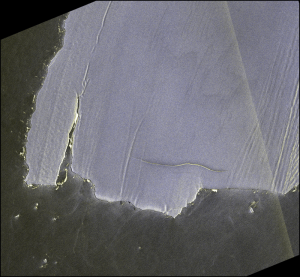 Latest Observation 2025.02.28 Fri The world’s largest iceberg, A23a, may have run aground on the continental shelf of South Georgia:
Latest Observation 2025.02.28 Fri The world’s largest iceberg, A23a, may have run aground on the continental shelf of South Georgia:
The trajectory of iceberg A23a observed by “GCOM-W”, “ALOS-2” and “ALOS-4” -
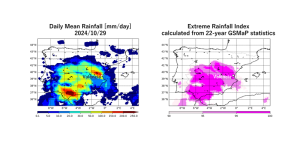 Latest Observation 2024.11.06 Wed [Quick Report] Heavy rainfalls in eastern Spain, as seen by the Global Satellite Mapping of Precipitation (GSMaP)
Latest Observation 2024.11.06 Wed [Quick Report] Heavy rainfalls in eastern Spain, as seen by the Global Satellite Mapping of Precipitation (GSMaP) -
 Latest Observation 2024.10.11 Fri Antarctic Winter Sea Ice Extent Second lowest in Satellite History
Latest Observation 2024.10.11 Fri Antarctic Winter Sea Ice Extent Second lowest in Satellite History










